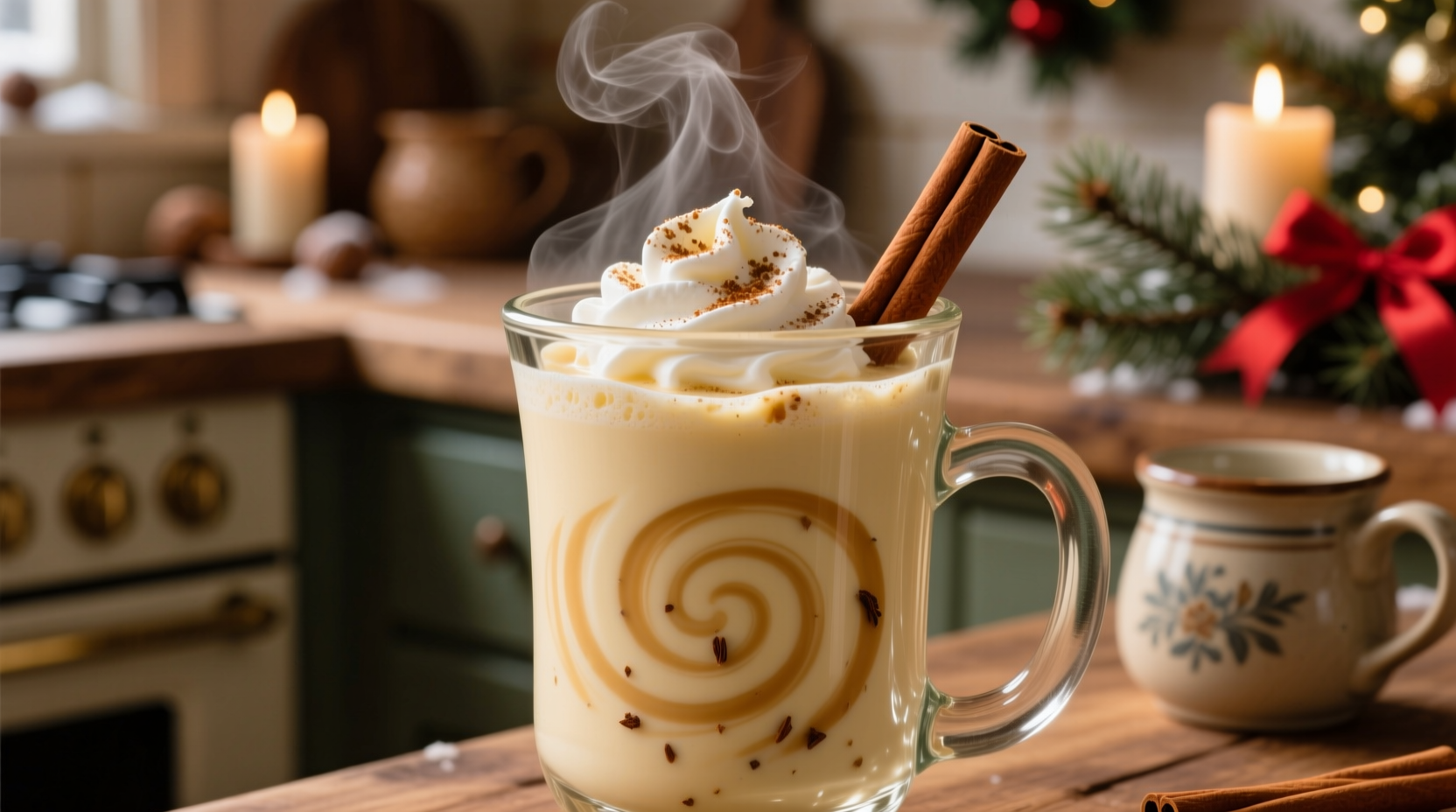If you've ever wondered what does eggnog taste like before trying it, you're not alone. This beloved holiday drink divides opinion like few others—some adore its comforting richness while others hesitate at the thought of raw eggs in their beverage. Let's explore exactly what makes eggnog taste the way it does, so you can decide whether it deserves a spot on your holiday menu.
The Essential Flavor Components of Traditional Eggnog
Understanding what eggnog tastes like requires examining its core ingredients and how they interact:
- Dairy foundation: The combination of whole milk and heavy cream creates a luxurious mouthfeel that's thicker than regular milk but smoother than ice cream
- Egg contribution: Raw egg yolks provide custard-like richness without an eggy flavor when properly prepared
- Sweetness balance: Typically 1/4 to 1/2 cup sugar per cup of dairy, creating noticeable sweetness that doesn't overpower
- Signature spices: Freshly grated nutmeg dominates, often accompanied by cinnamon, cloves, and allspice
- Optional spirits: Bourbon, rum, or brandy add complexity without overwhelming the base flavor
When properly balanced, homemade eggnog flavor profile should never taste "eggy" despite the eggs—instead, the eggs contribute to the custard-like texture while the spices mask any potential egg flavor.
Eggnog Compared to Similar Beverages
| Beverage | Texture Comparison | Flavor Similarities | Key Differences |
|---|---|---|---|
| Eggnog | Thick, creamy, smooth | N/A | Distinct spice profile, egg-based custard |
| Milkshake | Similar thickness | Creamy dairy base | Sweeter, lacks spices, no egg component |
| Custard | Nearly identical | Egg and dairy foundation | Custard is cooked, eggnog often contains alcohol |
| Melted vanilla ice cream | Close match | Sweet creaminess | Lacks spice complexity and egg richness |
This eggnog flavor comparison chart shows why many people describe eggnog as "spiced custard" or "holiday milkshake." The texture falls between a thick milkshake and melted vanilla ice cream, but the spice profile makes it uniquely its own.

How Eggnog's Flavor Has Evolved Over Time
The historical taste of eggnog has changed significantly since its origins. According to food historians at the Smithsonian Institution, eggnog evolved through several distinct phases that shaped its modern flavor profile (Smithsonian Food History):
- 13th-16th century: Medieval "posset" - ale or wine mixed with hot milk, eggs, and spices (more savory than sweet)
- 17th century: "Egg milk" - Eggs added to milk with sherry or brandy, minimal sweetness
- 18th century: Colonial adaptation - Rum became primary alcohol in American colonies, increased sweetness
- 19th century: Modern foundation - Vanilla and nutmeg became standard spices, cream ratios increased
- 20th century: Commercialization - Shelf-stable versions emerged, often with artificial flavors
- 21st century: Artisan revival - Return to fresh ingredients, higher quality spirits, and balanced spice profiles
Understanding this eggnog taste evolution timeline explains why modern eggnog tastes distinctly sweeter and more spice-forward than its historical predecessors.
Who Actually Likes Eggnog? Flavor Preference Insights
Consumer research from the International Food Information Council reveals interesting patterns about who enjoys eggnog taste and why (IFIC Food Preferences Study):
- 72% of eggnog enthusiasts prefer it with alcohol, citing enhanced complexity
- 68% associate positive memories with eggnog, creating psychological flavor enhancement
- 55% of first-time tasters need 2-3 exposures before developing a taste for it
- Common criticisms: "too sweet" (32%), "weird texture" (27%), "spices overwhelming" (19%)
This eggnog sentiment analysis shows that flavor preferences often develop with exposure and positive associations. If you're trying eggnog for the first time, consider starting with a small serving at proper temperature (chilled but not ice-cold).
Regional Variations That Alter Eggnog's Flavor
The regional eggnog taste differences across North America create distinct flavor experiences:
- New England style: Higher cream ratio, stronger rum presence, minimal spices
- Mid-Atlantic tradition: Balanced dairy, bourbon-based, prominent nutmeg
- Canadian variation: Often includes maple syrup, lighter spice profile
- Mexican "rompope": Thicker, sweeter, with stronger vanilla and cinnamon
- Commercial versions: Often use artificial flavors, thinner texture, less complex spice notes
When exploring what store-bought eggnog tastes like versus homemade, note that commercial versions often sacrifice complexity for shelf stability. The best store-bought options mimic the texture of premium vanilla ice cream melted to drinking consistency.
Tips for First-Time Eggnog Tasters
If you're curious about what eggnog tastes like but haven't tried it, these practical tips can enhance your experience:
- Serve at proper temperature: 40-45°F (4-7°C) – too cold numbs the flavor
- Start with small portions: 4 ounces lets you assess without commitment
- Look for fresh nutmeg: Bottled spice often lacks the bright note that defines eggnog
- Try alcohol-free versions first: Many dislike eggnog due to poor quality spirits
- Pair with complementary foods: Shortbread cookies or gingerbread balance the richness
Understanding how to appreciate eggnog flavor often comes down to managing expectations. Approach it as a dessert beverage rather than a standard drink, and you'll likely find its rich profile more enjoyable.
Customizing Eggnog to Match Your Palate
One reason why eggnog tastes different to various people is its adaptability. You can easily adjust recipes to match your preferences:
- For less sweetness: Reduce sugar by 25% and add a pinch of salt to balance
- Milder spice profile: Use only nutmeg (no cinnamon/cloves) and grate fresh
- Creamier texture: Increase cream ratio to 1:1 with milk
- Alcohol alternatives: Bourbon adds warmth, rum brings sweetness, brandy offers fruit notes
- Dairy-free version: Coconut milk creates similar richness with tropical notes
Professional chefs at the Culinary Institute of America recommend adjusting eggnog to personal taste by preparing a base recipe, then creating small test batches with different modifications (CIA Culinary Science).
Frequently Asked Questions About Eggnog Flavor
Does eggnog taste like eggs?
No, properly made eggnog doesn't taste eggy. The egg yolks contribute to the creamy texture without imparting an egg flavor, especially when combined with sugar, dairy, and spices. Commercial versions often use cooked eggs or egg substitutes that eliminate any potential eggy taste.
Why does eggnog taste different from regular milk?
Eggnog contains egg yolks and cream in addition to milk, creating a richer, custard-like texture. The added spices (especially nutmeg), higher fat content, and typical inclusion of alcohol create a completely different flavor profile from plain milk.
How does alcohol change eggnog's flavor?
Alcohol enhances eggnog's complexity—rum adds sweetness and depth, bourbon contributes warm caramel notes, and brandy brings fruit undertones. The alcohol also helps balance the richness, preventing the drink from tasting overly heavy. Non-alcoholic versions often require additional spice or vanilla to compensate for the missing complexity.
Why do some people dislike eggnog's texture?
The thick, creamy texture that defines eggnog falls outside typical beverage expectations. People who prefer lighter drinks may find it too rich. The texture comes from the emulsion of egg yolks, cream, and milk—when properly made, it should be smooth and luxurious, not slimy or chunky. Chilling thoroughly before serving improves the texture significantly.
Does store-bought eggnog taste like homemade?
Most commercial eggnog lacks the complexity of homemade versions. Shelf-stable versions often have artificial flavors and a thinner texture. Refrigerated cartons come closer to homemade quality, with many using real dairy and spices. The best store-bought options mimic the texture of premium vanilla ice cream melted to drinking consistency, but rarely match the nuanced spice balance of freshly made eggnog.











 浙公网安备
33010002000092号
浙公网安备
33010002000092号 浙B2-20120091-4
浙B2-20120091-4